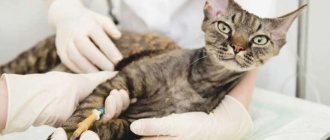What is chlamydia in cats
Chlamydia is an infectious disease caused by chlamydia microorganisms. There are more than 50 strains of them, each of them prefers its own host species, but can infect other species. Chlamydia in cats is caused by C. Psittaci, in humans – by C. Trachomatis.
A common feature of all chlamydia is intracellular parasitism. Unlike viruses, which also parasitize inside cells, chlamydia have a normal cellular structure characteristic of bacteria - a circular DNA molecule, ribosomes and a cell wall. This complicates the treatment of chlamydia.
How does infection occur?
Chlamydia lives in the cells of the mucous membranes of cats. These can be the mucous membranes of the eyes, nose, mouth, and genitals. Infection of an animal occurs in three ways - airborne, sexual and contact. The source of infection can be another cat, rodent or bird, less often a dog or person.
Adult animals most often become infected through airborne droplets when they are close to sick relatives. Bacteria are released when sneezing and coughing, their suspension remains in the air for 1-2 hours, so animals that live together quickly become infected from each other.
Kittens can become infected from their mother in two ways:
- When passing through the birth canal (a similar route of infection exists in humans), when the kitten’s mucous membranes come into contact with the infected mucous membranes of the mother;
- During grooming, when a cat licks kittens, her infected saliva comes into contact with the kitten’s mucous membranes.
A rarer method of infection is sexual. It is dangerous for both male and female cats, but due to the short duration of sexual contact in animals, the likelihood of infection is low.
Danger to humans
Feline chlamydia is contagious to humans. The route of infection is airborne droplets or when caring for a sick animal. It should be remembered that a cat can be an asymptomatic carrier and shed chlamydia. To avoid infection, you should not touch the faces of unfamiliar animals or kiss them. You can pet other people's pets whose health you don't know about, but after that you can't touch your own face, and you need to wash your hands quickly.
Human chlamydia can infect a cat, but this is unlikely. This is only possible if a person has chlamydia of the eyes or nose and kisses a healthy animal on the face or allows a cat to lick his face. It is easy to avoid such an infection, so a person is most often not dangerous to his pet.
Prevention
Chlamydia is an insidious disease not only for the pet, but also for the owner. It is very difficult for a kitten to experience and it is best to prevent its occurrence. Prevention and control of the spread of infection in cats is the key to the safety of animals and humans. To do this you need:
- vaccinate or otherwise inoculate cats against chlamydia;
- exclude visiting the street;
- visit the veterinarian regularly;
- fight rodents, as they can be carriers;
- carry out mating between a cat and a male cat only after a preventive examination.
Very often, the infection has a negative effect on the respiratory system and is characterized by an exacerbation of conjunctivitis. This disease also negatively affects humans. The most suitable option to combat the disease is to vaccinate the animal.
Forms of chlamydia in cats
Chlamydia in cats occurs in three forms - latent, acute and chronic.
In the latent form, the animal appears healthy. There are no signs of illness, the pet feels well, is active, and maintains an excellent appetite. However, the animal is contagious to other cats and humans. The animal is ill in a latent form if it has a strong immune system. Inside the cells, chlamydia is inaccessible to immune reactions, but infection of healthy cells is prevented by the body's defense reactions. The dose of bacteria released is the smallest possible.
The acute form occurs if the cat’s immunity is weakened or the infectious dose is too high. Chlamydia often occurs in this form in kittens, but adult animals are also susceptible to it. It manifests itself as profuse discharge from the eyes and nose, conjunctivitis, and lacrimation. If the mucous membrane of the genital tract is affected, there will be discharge under the tail. During this period, the animal is very contagious, including to humans.
The chronic form develops when acute chlamydia is untreated or when the immune system of a cat carrying a latent form is weakened. The disease manifests itself acutely with the appearance of a clear clinical picture. After treatment there is an improvement, but after a while the disease recurs. This may continue until the disease is completely cured.
Chlamydia in cats: symptoms
Early signs of the disease are nonspecific. The cat becomes lethargic, loses its appetite, sleeps a lot and hides in secluded places. An attentive owner will notice poorly groomed fur and a warm nose while awake, but high fever is rare in adult animals.
The main symptoms of chlamydia:
- Watery eyes, wet fur around the eyes.
- The appearance of purulent films on the eyes.
- There is discharge with pus in the corners of the eyes.
- The eyelids become swollen and take on a reddish tint, and the cat cannot fully open the affected eye.
- Photophobia – the animal avoids going out into bright light.
- Nasal discharge.
- Coughing and sneezing.
- Mild shortness of breath, snoring during sleep.
Damage to the eyes and nasal mucosa easily flows into one another.
Another common form is genitourinary. The only symptom is discharge from the urethra, frequent urge to use the litter box, and a stronger smell of urine than usual. But the disease can occur without significant external manifestations, affecting the genitals.
Chlamydia in cats leads to infertility, and in cats it leads to frequent miscarriages.
If the intestines are affected, then there are no manifestations of the disease. Vomiting or diarrhea may occur occasionally. The feces of a sick animal contain chlamydia and pose a danger to other cats in the house (animals have a habit of sniffing the “business” of their relatives).
There is a particularly dangerous form of chlamydia - generalized. Most often, kittens suffer from it. In this form, pathogens penetrate the blood and affect internal organs. The cat is rapidly losing weight, its temperature is rising, the animal is hiding in the corners and does not allow itself to be examined. Then she becomes lethargic, reacts poorly to external stimuli, does not eat or meow. Sometimes a pet can purr - this way it relieves its pain. There are no characteristic signs of generalized chlamydia, but the cat’s condition is extremely serious. Without treatment, death occurs within a few days.
How does infection occur?
The causative agent is intracellular parasites - chlamydia. Lacking their own energy metabolism, chlamydia parasitizes the cells of the body in which they settle. Reproduction occurs by binary fission. Infection of cats occurs through airborne droplets, less commonly through sexual contact.
Cat with chlamydia
Chlamydia in cats is also dangerous for humans; in close contact with an infected cat, the owner becomes ill with conjunctivitis. The disease can occur without obvious symptoms; about a third (according to some pathological data, 60%) of animals are latent carriers of this pathogen.
Chlamydia is transmitted through contact with stray animals or rodents, entering the body with secretions of the mucous membranes of the carrier of the pathogen and penetrating into the mucous membrane of a healthy individual.
For your information! Multiplying in epithelial cells, chlamydia enters through the circulatory system and massively colonizes the internal organs, joints, lymph, back and brain of the cat, affecting them.
What chlamydia looks like
Contact between a healthy animal and its carrier is not always direct. Chlamydia without a carrier maintains its vital activity for 48 hours, being in a warm, dark place with high humidity. When exposed to sunlight, they die within a short period of time.
Diagnosis of chlamydia
The veterinarian prescribes several tests for chlamydia:
- General and biochemical blood tests - reveals signs of inflammation and the immune response to it.
- ELISA – detects antibodies to chlamydia in the blood. The result does not reflect the severity of the animal's condition.
- PCR to identify pathogens. For analysis, discharge from the eyes, nose, genital tract, urine or feces of the animal is needed. Chlamydia is present in the blood only in the generalized form, so its analysis is not informative.
To identify a secondary infection, a swab from the throat, from the mucous membrane of the genital tract, and a stool test are prescribed. For cough and shortness of breath, a chest x-ray is needed.
Treatment
Chlamydia is successfully treated with a course of therapy using antibiotics (for example, tetracyclines, etc.) with the addition of immunostimulants, if necessary. Of course, such treatment is prescribed and supervised by a veterinarian(!). Since chlamydia in its pure form exists only in the initial stage of the disease, and later a secondary infection joins it, unqualified treatment can lead to insensitivity of the pathogen to drugs, or animals remain carriers of chlamydia, a control analysis is necessary after the course of treatment.
During treatment, infected cats should not have contact with other animals.
How to treat chlamydia in cats
The treatment regimen for feline chlamydia necessarily includes a long course of antibiotics. Only antimicrobial drugs can effectively fight parasites. The length of the course is due to the fact that bacteria inside the cells are inaccessible to antibiotics and the cat’s immune system. Erythromycin and Doxycycline are effective against chlamydia. They are prescribed in the form of intramuscular injections, and in severe cases - droppers. If the cat can take the tablets, antibiotics are given orally. The course of treatment is up to a month.
Local remedies to relieve the condition:
- Tetracycline ointment and antibiotic eye drops additionally fight chlamydia and prevent secondary infection.
- Eye drops with dexamethasone - eliminate inflammation.
- Balarpan eye drops – accelerate the recovery of the cornea and prevent the formation of a cataract.
- Chamomile infusion for washing the eyes has an additional anti-inflammatory effect.
When caring for an animal's eyes, they are first washed with chamomile, then drops (antibiotic-anti-inflammatory-restorative agent) are instilled, and tetracycline ointment is added last. If the cat actively resists treatment procedures, it is important to instill all the prescribed drops, but you can do without rinsing and ointment. The course of treatment is until symptoms disappear + 3 days.
For inflammation in the nose and genitals, local remedies are not used.
The treatment regimen for chlamydia in cats necessarily includes means to strengthen the immune system and restore intestinal microflora. They are used in capsules or injections. The choice of dosage form depends on whether the pet can eat tablets or whether it is safer to inject the drug into a muscle. The course of treatment is 1 month.
If there are several animals living in the house, they all receive the same course of injections or tablets. Local procedures are prescribed only to sick cats. Healthy animals (especially kittens) have their eyes washed with chamomile as a preventative measure.
Caring for a cat when sick
To avoid infection, a sick cat is placed separately from other animals. If possible, she is given a private room during her illness. Her bowl, drinking bowl, tray, bed, scratching post and toys are placed there. Wet cleaning is carried out daily, bowls and drinking bowls are washed. The tray is cleaned as it is filled, preferably as soon as the cat has done its business. Soft items - bedding and toys - are washed once a week, separately from people's clothes and other cats' household items.
The animal needs to be fed wet food; it is better to temporarily switch to kitten food. To restore microflora, yoghurts without sugar and sweeteners are useful. If the owner can’t afford it, you can limit yourself to kefir or regular milk. This dietary supplement is allowed only if the cat tolerates dairy products well. Otherwise it will only get worse for her. Water must be constantly available and in large quantities.
Since chlamydia poses a danger to humans, children should not be allowed to care for a sick cat. It is better if only one family member is involved in treatment. There is no need for special protective equipment; it is enough to wash your hands immediately after contact with a sick animal and not bring its muzzle closer to your face. You can pet the fluffy one and let him climb on your lap.
If the cat is alone in the house, and the owners do not have small children, then it is not necessary to isolate it. It is enough to keep the animal out of the bedroom so that it does not spread chlamydia onto human pillows.











